Abstract
The rivers of south-eastern Australia flow within a complex meander tract (Coonambidgal Formation) formed by phases of Quaternary stream activity. Pumping tests, hydrochemistry and groundwater monitoring of the Campaspe, Loddon and Murray River Valleys show that for significant parts of their courses, the rivers and their associated strip aquifers form a single integrated hydraulic unit perched above and disconnected from the regional water table by an underlying aquitard developed at the top of a varyingly thick and temporally dynamic vadose zone. Loss to the regional aquifer is not restricted to the riverbed but covers the entire width of the Coonambidgal Formation aquifer, which is one or two orders of magnitude greater. River-bed flux is not a measure of net river loss. Through diffusion and dispersion from the overlying saturated zone, aquitard enhancement or development is augmented by chemical processes active towards the top of the vadose zone. Unlike river-bed clogging, chemical clogging of aquifers is progressive and permanent. Post-European instability in the studied groundwater systems has seen catchment wide groundwater rises of up to 0.25 m/y. or 25 metre over the last century. Under the pre-existing norm of deeper water tables, disconnected streams would have been more numerous with the present aquitards being a legacy of that regime.
1. Introduction
The incidence and history of disconnected (perched) river systems across the Riverine Plain of south-eastern Australia is not widely appreciated and their connection to the aquifers poorly understood [1,2,3]. If recognized, they are seldom discussed. Sound water management requires a good understanding of the nature of river–groundwater flux, however such deficiencies often lead water managers and modelers seeking a credible water balance to assume that aquifers and streams are seamlessly connected, and that groundwater pumping in their vicinity will cause stream depletion. An over-emphasis on assumed connections between rivers and groundwater adversely impacts management decisions on river susceptibility, groundwater availability, and the nature and protection of river-related groundwater dependent ecosystems.
Disconnected systems may occur naturally or may evolve from connected streams through groundwater pumping which progressively lowers the water tables [1,2,4]. There is a strong degree of instability in Australian groundwater systems which in response to European land-use changes have seen regional water tables in Victoria rise at rates of up to 0.25 m/y. or 25 m over the last century [5,6,7,8]. The rises peaked in about 2000, and then fell in response to the 12 year long millennium drought and the consequent increased intensity in groundwater extractions. The rise then fall in groundwater levels strongly impacts the degree and extent of river-groundwater connectivity.
Key uncertainties in connectivity relate to the quantification of the exchange of water between streams and aquifers, and the potential impact that groundwater extraction may have on stream flow [1,9,10,11,12]. There are two fundamental aspects of the problem one relating to field observation/data collection and the other to model applicability. The former, with which this paper deals, requires field methods that allow the identification of the nature and extent of connection, essential for model conceptualization and calibration [13,14].
The progressive disconnection of rivers over time from the underlying groundwater system is commonly attributed to and deemed an inevitable consequence of clogging of the channel sediments [1,4,15,16,17,18,19]. Clogging is induced by physical, biological, and chemical processes. Riverbed clogging is principally by physical processes by entrapment of suspended particles, while chemical clogging is from redox reactions and pH variability usually concentrated deeper in the sequence [20]. Clogging of channel sediments is exacerbated where groundwater pumping increases the rate of river loss to the groundwater system, but this may in turn lead to river disconnection as water tables fall causing the development of a vadose zone wherein chemical clogging of the aquifer is enhanced [1,4,18,21,22]. Both riverbed and underlying aquifer clogging are a problem with riverbank infiltration schemes where nearby wells are used to increase recharge to the groundwater through the beds and banks of streams [4].
Comprehensive studies of disconnected rivers in neighbouring NSW show that for disconnection to occur, there must be an intervening aquitard and an unsaturated (vadose) zone between the river and the water table [1,23,24,25,26,27]. The aquitard consists of a clogging layer with a significantly lower hydraulic conductivity than the underlying aquifer being ‘near or slightly below’ the streambed, usually a clay unit 0.5 to 2 m thick [14]. The NSW study extended the zone of clogging into the aquifer/aquitard below the streambed and showed that the aquitard need only be thin. Criteria for disconnection focusing on the aquitard and mounding in the underlying groundwater were quantified by Brunner et al. [1], and a review of river disconnection was undertaken by Brunner et al. [3]. with the focus remaining on the riverbed—“A common denominator in the different disciplines is the streambed. The streambed constitutes the interface between the river and groundwater, and it controls river-groundwater interactions”. However, while temporal and spatial factors in river loss had previously been examined, they covered the significance of the transition zone which develops as a river passes from connected to disconnected status [2].
Like riverbed clogging, aquifer clogging is common, and causes declines in recharge rates and ultimately the end of the recharge system. Aquifer clogging is characteristic of artificial recharge basins sited atop a vadose zone, with clogging occurring at the infiltrating surfaces. Similar problems occur in injection wells and experimentally with sand columns [18,20,28,29,30,31,32]. In laboratory columns an initial decline of an order of magnitude was recorded in the hydraulic conductivity (K) from 0.78 m/day to 0.062 m/ day in the first 7 days of an experiment. This was thought to be due to physical clogging by suspended solids and then biological clogging by biomass accumulation and polysaccharide production at the inflow end of the columns [30]. In a survey of 40 aquifer injection wells, 80% of them suffered from clogging problems, among which 70% were caused by suspended solids and gas bubbles, 15% by microbial growth, 10% by chemical precipitation, and 5% by other causes [33].
A recent review of state of the art approaches in characterizing and modelling [3] notes that, despite recent advances in the field of numerical models, current modelling practice is still far away from incorporating the full complexity of surface water and groundwater interactions. The simplified conceptualization of complex surface water-groundwater interactions creates major uncertainties that potentially remain undiscovered given limited field observations that are used in the modelling process. A more holistic approach is required. They note that although the integration of these various approaches and disciplines is advancing, major research gaps remain to be filled to allow more complete and quantitative integration across disciplines.
While the above studies have focused on streambed permeability and flux, there are other fundamental features of the rivers and groundwater systems of southeastern Australia pertinent to an understanding of the river-(regional) aquifer connectivity. These factors are both physical and temporal, reflecting the geomorphology of the riverine landscape, and the temporal instability of the regional groundwater systems. On the Riverine Plain the rivers are largely confined within meander belts formed over time by successive phases of Quaternary ‘ancestral river’ activity forming linear strip aquifers (Coonambidgal Formation) across the plain [34,35,36,37,38]. The final phase of Coonambidgal river activity includes that of the modern rivers and consists predominantly of fine grained sediments, clay, silt and fine sand, with a basal riverbed coarse grained layer of sand, gravel and at times pebbles deposited by successive channels as the river migrated across its restricted flood plain. The basal composite riverbed layer is the principal aquifer in the otherwise fine grained suite of Coonambidgal Formation sediments, with the present riverbed as the outcrop of the aquifer at the surface. Connection to the regional aquifer is therefore, not simply by the riverbed but by the entire area of subcrop of the channel sand aquifer, whose width is 1 to 2 orders of magnitude that of the river. Where there is strong interchange between the river and containing aquifer, riverbed flux and permeability are not a measure of potential river loss to the regional water table. Given the instability in the aquifer systems since European settlement, which has seen significant water table rises, the past distribution of disconnected rivers was significantly greater than at present. Chemical clogging producing or enhancing aquitard development is both progressive and permanent, and where impacted, the present day aquitards are both a legacy and continuation of the earlier condition.
2. Objective
In order to provide further understanding of the nature of disconnectivity, this paper examines the rivers in terms of a spatial and temporal framework. The study considers the rivers as the surface expression of a fully integrated joint two-component river-strip aquifer system whose interchange reflects river stage. Disconnection is in the perspective of an unstable groundwater system with a water table that has undergone significant re-adjustments in recent times. It examines four disparate examples of disconnected streams from across northern Victoria. The streams are the Pyramid Creek east of Kerang, the Campaspe River between Barnadown and Elmore, the Bullock Creek at Marong and the Loddon River near Baringhup (Figure 1). The Loddon River and Campaspe River sites occur within their highland tracts, the Campaspe site near its emergence on to the plains. The Pyramid Creek is in a far floodplain situation at the junction of the Loddon and Murray River provinces. It lies in an area heavily flood-irrigated, while the Loddon and Campaspe River sites are within groundwater management areas irrigated by groundwater. The Bullock Creek is non-irrigated being in an unexploited dryland site within an embayment in the highlands. Stream gauges are present in the cases of the Bullock Creek, Loddon River and Campaspe River sites enabling relationships between stream flow and groundwater response to be determined. Pyramid Creek is used as a major water carrier carrying water from the Murray River supplied Kow Swamp storage which is used for both irrigation and environmental purposes in the Kerang Lakes. Much of the study is based on hydrographic data from the Victorian Government Water Information System All sites have historical groundwater data, in several cases extending back to the first decade of the previous century enabling an historical perspective on present day river disconnection. The variety of sites with both their commonality of features and their discrete differences enables a broader understanding of the nature of disconnected rivers through an emphasis placed on physiography and time, rather than river-bed reflux.
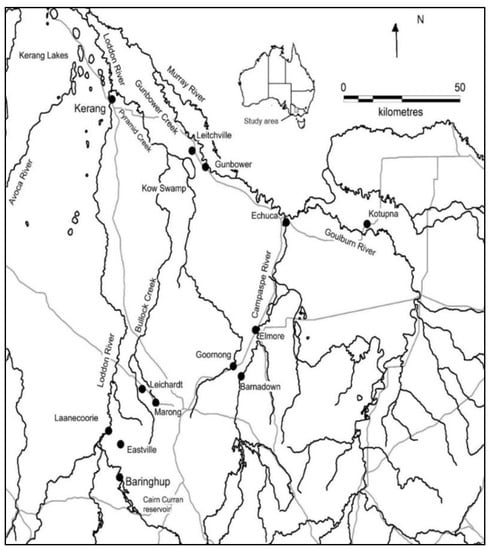
Figure 1.
Rivers and streams of north-central Victoria, Australia with disconnected streams described here–the Campaspe River east of Goornong, the Loddon River at Baringhup, Bullock Creek at Marong and the Pyramid Creek, west of Kow Swamp.
3. Materials and Methods
This study uses historical data of groundwater levels, hydrochemistry, lithologic logs and stream flow to gain further understandings of the nature of disconnected river systems. Much of the information is distilled from the writer’s earlier works carried out across northern Victoria. Earliest data on groundwater levels comes from the gold mining records dating back to the 1850s, when exploring for gold in the alluvial fill of major highland valleys. Referred to as the Deep Leads they were both a prodigious source of gold and of water. The Deep Leads were later recognized as the major non-marine aquifer system (Calivil Formation [39]) in the Murray Basin of S.E Australia. Lithological logs, groundwater levels and salinity data from the gold mining era documented the pre-development groundwater system. It provided a base line from which to recognize the groundwater instability which was later shown to be the cause of the country’s widespread salinity crisis in the 1970s to 1990s [6,8]. With land and waterways becoming salinized it led to further intense data collection with a focus on surface-groundwater interactions. However, this phase was ended by the 14 year long Millennium Drought from 1997 to 2010/11 when rivers were impacted by groundwater pumping, again shifting the emphasis, and causing a further hectic collection of groundwater data. The bulk of the information was stored in the Victorian Government Groundwater Database instigated by the Victorian Department of Mines in the early 1960s, which incorporated data from existing and earlier programs designed to investigate the State’s water resources. The plethora of groundwater and surface water data provided detailed monthly water level and salinity information enabling a reconstruction of the evolution of the groundwater systems at a basin-wide level, including the evolving relationship between groundwater to rivers. The groundwater response to the various processes spotlights its ongoing role in river connection and disconnection—the focus of this paper.
4. Analyses and Results: Quaternary Rivers of North-Central Victoria
The southern Riverine Plain of S.E Australia is underlain by up to 100 m of fluvio-lacustrine sediment consisting of a deeper sand, gravel and pebbly Calivil Formation [39] and an overlying sand and clay Shepparton Formation [37]. Despite commonly being seen as aquifer and aquitard, in the highlands and across the upper Riverine plains groundwater levels in both the Calivil Formation and Shepparton Formation closely correspond, and they respond similarly to seasonal pumping, indicative of a single unconfined to semi-unconfined system [40]. On passing further down-basin, the Shepparton Formation becomes increasingly clayey and on the far plain is an aquitard to the Calivil Formation [8]. Recharge of the aquifers is from precipitation and from the rivers. The Calivil Formation is the major aquifer exploited in northern Victoria carrying water from recharge areas within the highlands to discharge zones in the lower plains. It is most strongly developed for irrigation purposes in the Loddon, Campaspe and Murray River valleys, where groundwater salinities are lowest.
The present-day major rivers flow within narrow inset terraced meander belts, formed by successive phases of late Quaternary fluvial activity, whose superimposed sedimentary sequences, the Coonambidgal Formation [37] forms linear strip aquifers across the plain whose water is river sourced. Three phases of Coonambidgal Formation river activity were originally recognized and referred to as Ancestral Rivers—AR1, AR2 and AR3 [34,35,36]. The earlier two of late Pleistocene age have a large meander wavelength and are high energy systems with coarse sandy bed-loads [38,41,42,43]. The most recent (AR3) phase is post glacial of late Pleistocene-Holocene age and includes the modern rivers and their associated terraces. Unlike earlier stages, AR3 is a low energy fine sand, silt and clay system, but with a basal riverbed layer of coarse-grained sand, gravel and pebbles deposited in successive channels as the rivers migrates within restricted flood plains [36]. The basal layer which connects to the recent riverbed deposits is the principal aquifer in the otherwise fine grained suite of Coonambidgal Formation AR3 sediments, enabling lateral transmission of river water across the terrace (Figure 2 and Figure 3). Piezometers established on the Coonambidgal terraces, monitor groundwater responses to river flow. The use of river gauges and piezometers shows the close response of groundwater levels to streamflow, notably as sharp spikes reflecting rapid river rises, followed by slow declines in response to return flow.

Figure 2.
Coonambidgal Formation terraces on the Goulburn River (modified from Bowler [36]). The section shows basal channel bed sequences linked to the river.
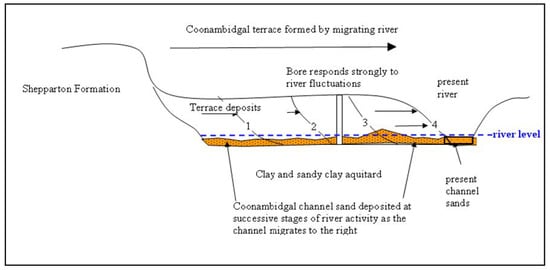
Figure 3.
Conceptualization of river-aquifer interconnectivity from the Campaspe River at Avonmore of the basal Coonambidgal Formation channel sands, the river channel, and the aquitard [40].
Eucalypt forests developed on the river terraces tap the fresh groundwater and are high potential Groundwater Dependent Ecosystems (GDEs)–Bureau of Meteorology (BOM). The Campaspe and Loddon River examples lie in groundwater management areas where there is extensive extraction from the aquifers and both rivers and associated GDEs are deemed to be threatened by pumping from the regional aquifers. To protect the rivers and GDEs, management prescribes minimal distances from the rivers for extraction bores, these distances are set and commonly determined by models.
4.1. The Pyramid Creek
While for much of their courses the Ancestral Rivers remain as superimposed terraces incised into the plain, in the lower plains nearer the Murray River in the Echuca area, the paths diverge in response to neotectonics [35,36,43]. The separation of the AR phases of the Murray, Goulburn and Campaspe Rivers enables their clearer distinction as discrete morphologies. In the north of the study area, the course of the earliest AR1 system, there called the Mead Stream, passes to the north of Kow Swamp (Figure 4), but further upstream it is obliterated by the later AR2 phase fostering the Gunbower Creek, and the modern AR3 phase Murray River. The Mead Stream trace is that of a large wavelength meandering dry leveed and crevassing system with occasional low source bordering sand dunes on the downwind (eastern) side of meanders. Beyond Kow Swamp the AR1 meander tract is picked up by the Pyramid Creek and later the Loddon River, both being AR3 misfit streams with an adopted AR1 meander wavelength (Figure 4 and Figure 5).
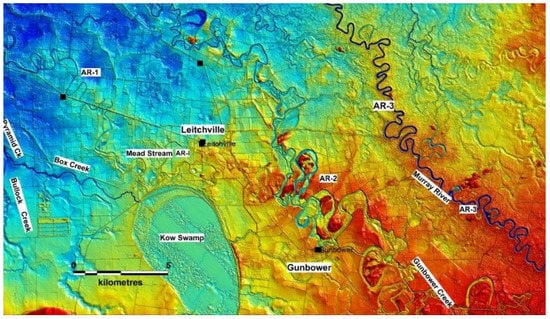
Figure 4.
Ancestral stream types in the vicinity of Kow Swamp, north-central Victoria. An AR2 phase of the Goulburn-Murray system is represented by the largest meanders with high source bordering dunes deflated from sandy point-bars and along which the modern Gunbower Creek now flows as a misfit stream. A separate parallel course to the north is taken by the AR3 phase including the modern Murray River. An AR1 phase passes to the north of Kow Swamp to be later joined by the Pyramid Creek and Loddon River (vicmap-elevation-dem-10 m–modified).

Figure 5.
Pyramid Creek flows as a misfit stream having the long wavelength of the late Pleistocene AR1 system, also adopted by the Loddon River, an AR3 system which joins Pyramid Creek further north at Kerang. (vicmap-elevation-dem-10 m–modified).
Detailed drilling across the AR1 tract occupied by the Pyramid Creek shows a 20–23 m thick Coonambidgal Formation sequence consisting of fine to coarse sand with clay intercalations, (Table 1) containing water with salinities from 20,000 to 35,000 mg/L. At the base of the Coonambidgal Formation is a channel sand underlain by firm ‘plastic’ clays of the Shepparton Formation. The sand sequences are in marked contrast to the silts and clay of the Holocene AR3 phase, which in the case of the Loddon River at Baringhup is an upper silt underlain by humic clay and humic clayey pebbles.

Table 1.
Lithology and stratigraphy through the Coonambidgal Fmn. AR1 trench.
4.2. Hydrogeology of the Ancestral River Phase 1 and Its Pyramid Creek Surrogate
The Pyramid Creek marks the boundary of the Loddon and Murray River Plains. It was a shallow westward flowing collector stream for the northwards flowing Loddon Valley streams including Bullock Creek, Nine Mile Creek, Calivil Creek before becoming tributary to the Loddon River at Kerang. Flood irrigation was introduced into the region in 1884 when groundwater levels were at a depth of 6 to 9 m [44]. However, the underlying saline water table rose rapidly, with land salinization becoming an issue by the early 1900s. The problem was greatly exacerbated following the completion of the Torrumbarry Weir in 1923, after which ca 1000 mL/day of fresh water was carried 60 km from Kow Swamp to the Kerang Weir via Box Creek and Pyramid Creek, (Figure 5).
When surveyed in the 1930s, saline groundwater levels were already in places less than 2 m from the surface and rose to 0.6 m seasonally after irrigation [44]. Bores 40307 and 6493 located to the east of the Pyramid Creek are indicative of the high saline regional water table between 1964 and 1992 (Figure 6). The salinity in bore 6493 was 56,000 EC (mS/cm) in 1971 and 62,300 EC (mS/cm) in bore 40307 in December 1988. The rapid rise in water tables under irrigation despite the heavy clay soils was examined in a four-year study of infiltration rates across a typical area of the irrigation district using an artificial 3 ha unsealed laterally constrained pond. It found that about 50% of the applied water evaporated and 50% infiltrated [45]. Fissuring and gypsum precipitated from the groundwater enhanced the vertical permeability.
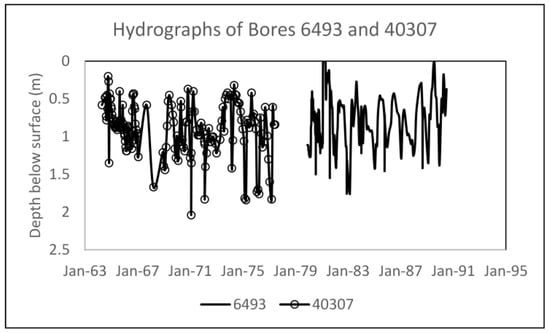
Figure 6.
Static water levels in the vicinity of the Pyramid Creek shallow (3 m) bores 40307 and 6493. The salinity of 6493 was 62,300 EC (μS/cm) in December 1988.
Prior to 1939, the creek, then a major freshwater carrier, was hydraulically isolated from the surrounding high saline water table. This situation was recorded by Baldwin et al. [44], who as part of a broader soil and salinity investigation examined leakages from irrigation channels, noted that “the bed of the Pyramid creek which is used as a water carrier is relatively impervious”. However, the isolation of the Pyramid Creek ended abruptly in 1968 when it was deepened by 1.6 m over a 60 km length between Kow Swamp and Kerang to gain greater access to the Kow Swamp supply basin. The deepening of the creek removed the underlying aquitard and caused an annual influx of saline water containing 50,000 tonne of salt. The consequences were severe for the environment attributes of the Ramsar listed Kerang Lakes, agricultural production and the Murray River further downstream. To counter this, in 2001 an extensive set of 113 groundwater pumps was established along a 12 km stretch of the creek to lower the adjacent saline water table, but further requiring the establishment of a local evaporating basin for the removal of the 22,000 tonnes of salt produced annually by the pumps.
The processes protecting the creek from saline influx were in place during the 1920s, when a shallow saline water table had already become a problem. The simplest explanation for disconnection from the water table is riverbed clogging. Clogging of stream beds is a common occurrence resulting mostly from the infiltration of fine sediment, but also the accumulation of both organic and inorganic suspended solids, precipitation of carbonates, iron and manganese (hydr)oxides and biological processes. (Seti et al., 1998; [18,28,46]. The process is reversed during periods of higher flows when the channels sediments are scoured.
The formation then cutting of a clogging layer similar to that which occurred at Pyramid Creek was documented recently in the Warka River in Poland where river bank infiltration (RBI) is used to purify river water. River clogging was a problem exacerbated by enhanced recharge/throughflow from pumping. However, pumping at times of drought led the development over three sections of a 1–2 m thick aeration (vadose) zone beneath the river. It was noted that chemical clogging is extremely effective once the water table drops below that of the river with the precipitation of soluble ions in the unsaturated zone causing aggregation of the sediments. Excavations along the river-bed to a depth of 5 m removed the clogged zone, and the river water influx caused a rise in groundwater levels to 1 m above the river floor restoring saturated flow between the river bed and the groundwater [4]. The physical clogging of the riverbed sediments mostly by silt and clay was readily reversed by high flows which cause deep river bottom scouring. However, this is not the case with the underlying aquifer, where chemical clogging forms progressively and is permanent. Hu et al. also observe that chemical clogging occurs over time and is irreversible.
Clogging explains the isolation of the Pyramid Creek until its channel was breached by a 1.6 m cut. However, prior to the introduction of irrigation, a 6–9 m vadose zone already underlay the creek and conditions conducive to chemical clogging were the norm. A likely clogging zone is recorded in Bore 41594 (Table 1) between 0.6 and 7.3 m where a 1.8 m orange sandstone layer is underlain by black (humic rich) clay then orange silty clay. The orange colours are typical of iron clogging including cementation [47] while black clay is a feature of waterlogging under anaerobic conditions typical of gleying [48].
Therefore, while river-bed clogging provides a simple explanation for the protection of the Pyramid Creek, a more likely rationale lies in its long historical isolation as a perched low-flow system sitting above the saline regional water table in a position conducive to clogging at the top of the vadose zone. Whatever riverbed clogging occurred would be augmented by chemical clogging in an underlying 1.6 m thick unsaturated confining layer. Unlike river-bed clogging which is readily destroyed by high stream flows this would not be the case with clogging below the river-bed.
4.3. Background
Along its course a river may have reaches that are connected and disconnected (Winter et al., 1999). With disconnected stream there is no loss by saturated flow but loss through an aquitard my occur by gravity flow. The term ‘disconnected-losing’ was introduced to cover river loss by gravity flow from an otherwise disconnected river. However, given this understanding, the term is deemed unnecessary for this paper. The change from a disconnected to connected stream is readily seen along the course of the Campaspe River which is tributary to the Murray River at Echuca (Figure 1). In its highland tract between Barnadown in the south and Elmore, the AR river phases are confined to a Coonambidgal trench about 0.3 to 1 km wide, which traverses a narrow bedrock bounded plain until Elmore (Southern Campaspe Plain–Figure 7) after which it becomes laterally unconfined (Figure 8). Emerging from its Coonambidgal trench the river has built an elevated delta-like Campaspe Fan aggraded by crevassing over-bank streams with associated coarse grained shoe-string sand aquifers, the down-basin equivalents of the previously confined AR1 and AR2 phases. The coarse sandy soils and sediments of the fan are the principal recharge area on the Campaspe Plain with recharge from the Campaspe River, direct recharge from rainfall and recharge from the east–west Waranga channel crossing the fan [49].
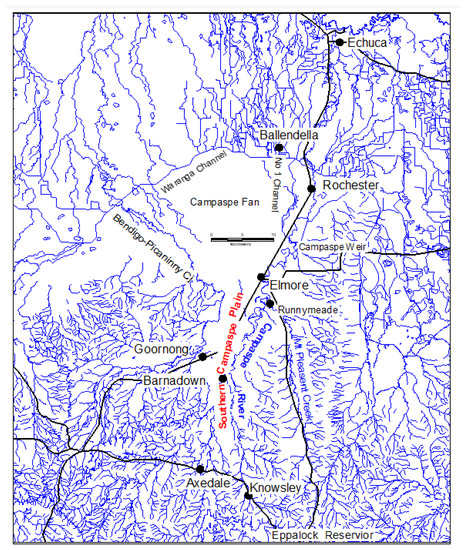
Figure 7.
The geomorphology of the Campaspe Valley showing the Southern Campaspe Plain and the Campaspe Fan. High density dendritic drainage pattern on the valley sides is responsible for high volume storm recharge to the Plain [50].
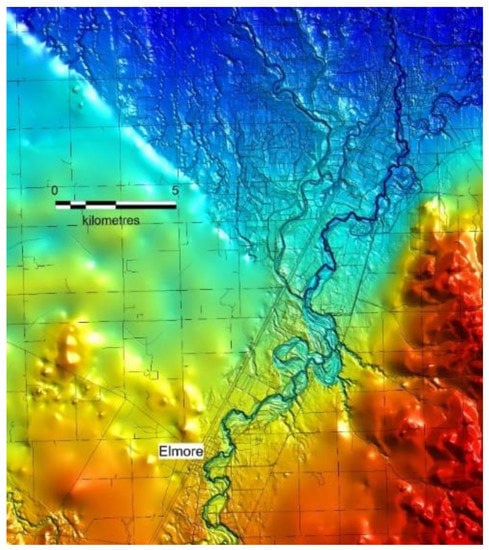
Figure 8.
The change in stream morphology of the Campaspe Valley to the north of Elmore from an incised Coonambidgal Formation terrace system to an anastomosing shoe-string sand regime forming the Campaspe Fan. (vicmap-elevation-dem-10 m–mod.).
The present Campaspe River flows lateral to the fan as a low sinuosity stream The change in morphology from a confined terrace system to an unconstrained crevassing fan is repeated on the Loddon River, with the Loddon Fan having its apex at Serpentine [8]. The Campaspe Fan with its highly permeable sediments and soils is the principal groundwater recharge area in the Campaspe Valley, with recharge coming from direct precipitation, the Campaspe River, valley-side storm runoff, irrigation returns and leakage from the Waranga and Campaspe No 1 Channels. Modelling has shown that in the irrigated areas groundwater recharge has increased from 10 mm/y. to 100 mm/y [51,52,53,54]. Groundwater extraction occurs along the entire length of the Campaspe Valley, mostly from the Calivil Formation aquifer. However, the diverse range of views expressed in previous works on the Southern Campaspe Plains demonstrates the difficulties of conceptualization, which creates a reliance on off-the-shelf models when determining river-groundwater interactions. It underscores Cook et al. [13], who state that robust field methods are required which allow the identification of the state of river-groundwater connections.
Numerous studies including groundwater modelling of river-groundwater interactions have been carried out on the Southern Campaspe Plains, both supporting and opposing the view of a strong river contribution to the regional Calivil Formation aquifer [49,50,54,55,56,57,58,59,60,61,62,63,64,65,66,67,68]. At Fergusons Bridge on the Campaspe River, an intense study involving drilling and monitoring was specifically designed to determine the impact of nearby groundwater pumping on river leakage but led to strongly opposing conclusions. Previously, Neivandt [50] on the basis of 240 infiltrometer tests observed a strong interaction between the river and the Coonambidgal Formation but noted that the Coonambidgal Formation is incised into the heavy clays of the Shepparton Formation, which are of low permeability and there was little recharge. Leonard [69] also comments that the modern-day Campaspe River is incised into the clayey upper Shepparton Formation. He further comments that on the basis of both geologists’ and drillers’ logs, gamma logs and water level data at the Fergusons Bridge site there is compelling evidence for the existence of a significant clay layer (aquitard) between the base of the Campaspe River and the underlying regional groundwater.
4.4. River Connection and Disconnection via the Coonambidgal Formation—Fergusons Bridge to Elmore
4.4.1. Disconnected Campaspe River/Coonambidgal Formation Aquifer at Avonmore
The close relationship between the Coonambidgal basal aquifer and the Campaspe River and their position perched above the regional water table is shown for sites located in the Southern Campaspe Plain between Fergusons Bridge and Elmore (Figure 9). Similar responses to river flow are recorded in Coonambidgal Formation piezometers at Fergusons Bridge and Avonmore, indicating continuity of river-groundwater exchange along the river (Figure 10). The sites are situated on the Coonambidgal terrace and underlain by the Shepparton and Calivil Formations. The sites have long hydrograph records from dual piezometer nests screened in both the Calivil Formation and Coonambidgal aquifers. The Fergusons Bridge site was designed specifically to understand river-groundwater interactions and has a number of piezometer nests screened at varying depths, both on the terrace and on the nearby plain.
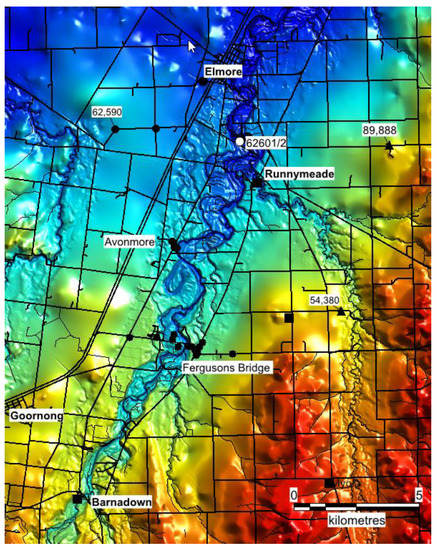
Figure 9.
The course of the Coonambidgal trench across the Southern Campaspe Plain with the Ferguson Bridge, Avonmore and 62601/2 Coonambidgal Formation sites and lateral bores (vicmap-elevation-dem-10 m–mod).
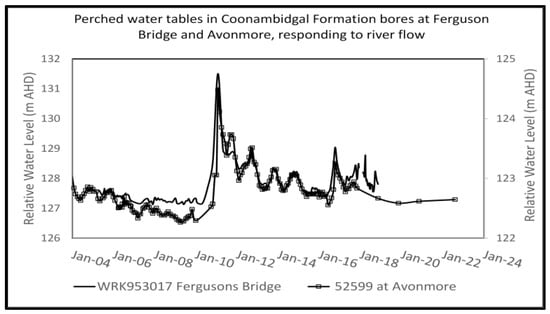
Figure 10.
Hydrographs of the Coonambidgal Formation bores WRK953017 at Fergusons Bridge and 62599 at Avonmore 4 km downstream (locality Figure 9). Both bores are connected to the river but perched above the regional water table.
At Avonmore a piezometer nest on the river terrace monitors the Coonambidgal channel aquifer in bore 62599 and the Calivil Formation aquifer in bore 62595. The channel sand aquifer is underlain by 10 m of sandy clay and clay forming an aquitard at the top of the Shepparton Formation, the upper parts being within a vadose zone. Bore 62599 shows a perched water table (Figure 11) within the Coonambidgal Formation channel (riverbed aquifer) that corresponds to river level and fluctuates accordingly Figure 12). Potential loss to the underlying aquifer is not centred on the river but occurs via the entire area covered by the base of the Coonambidgal terrace whose width is about 1 km wide, while the river is about 25 m wide. The regional water table in the Shepparton Formation at Avonmore is ca 5 m lower than the river, with an interceding 10 m thick clay and sandy clay aquitard occurring below the terrace channel sand. Both an aquitard and a vadose zone are present, which is in accord with previous NSW studies where an aquitard and a vadose zone are a requirement for perching [1]. The water table in the terrace aquifer in August 2022 was 7.7 m higher than that in the Shepparton Formation with a 4 m thick vadose zone, there partly developed within the aquitard.
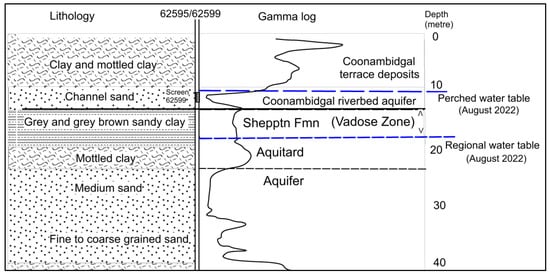
Figure 11.
Lithologic and gamma-log profiles for bore 62595 located on the Coonambidgal terrace of the Campaspe River at Avonmore showing a perched Coonambidgal Formation aquifer with a water table approximating river level and both elevated 5 m above that of the regional water table (gamma-log and lithology from Pratt [70] and Leonard and Macumber [66]).
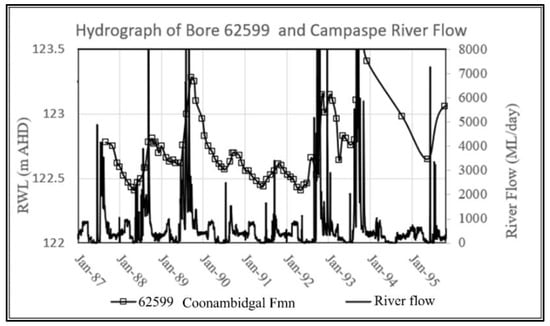
Figure 12.
Hydrograph of Coonambidgal bore 62599 at Avonmore showing its strong connection with river flow by the coincident of peaks, sharp rises and slow declines following high flow events. The aquifer is behaving like a river gauge and its level deemed to be equivalent to that of the river.
Strong connectivity to the river is shown by the close accord between fluctuations in river flow (mL/day) and the water table. Sharp spikes of flood events in 62599 are followed by a slower decline during the period of return flow (Figure 12). With respect to the Coonambidgal Formation aquifer, at Avonmore the river-groundwater flux oscillates between discharge and recharge and it is an alternating losing-gaining stream, albeit disconnected from the regional water table. Given the ready exchange, values of stream bed transmissivity are not a gauge of net river loss to the regional aquifer. Instead, loss is by gravity flow from the basal aquifer including the river bed across the aquitard. There is no response in bore 62599 to either seasonal groundwater pumping or longer term trends in aquifer levels observed in the Calivil Formation bore 62595 (Figure 13), suggesting no direct connection between the river/Coonambidgal Formation system and the Shepparton Formation/Calivil Formation aquifer. River connection to the regional water table occurs further downstream at Elmore [40], but first appears in Bore 62602 between Avonmore and Elmore (Figure 14).
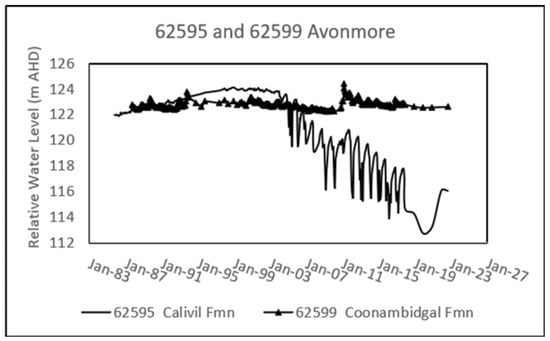
Figure 13.
Groundwater levels in the regional Calivil Formation aquifer (62595) and in the Coonambidgal riverbed aquifer (62599). The level in 62595 briefly exceed those of the Coonambidgal bore 62599, but rapidly fall away once intensive pumping commences as shown by large seasonal fluctuations. The Coonambidgal Formation and river are disconnected from the regional aquifer.
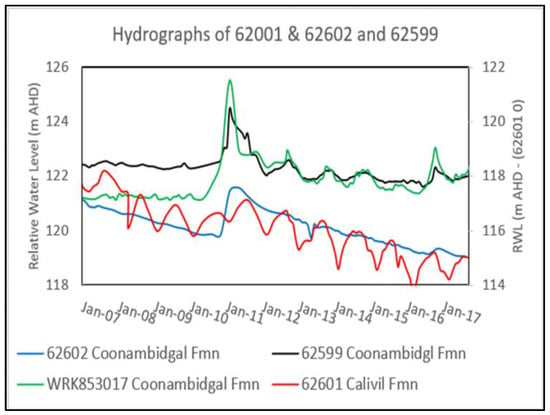
Figure 14.
Hydrographs showing the parallel fall in levels in bore 62601 to that in the Calivil Formation bore following regional trends, while disconnected bores 62599 and WRK853017 bores remain unaffected, being only influenced by river flow. To enable comparisons, 6 m has been removed to the levels of upstream bore WRK8530174.
The Statewide reversal of trends in the regional water table is shown in Bore 62585. Up to the year 2000 groundwater levels were rising in bore 62595, but then reversed and began to fall in response to groundwater pumping induced by the 13 year long millennial drought. Prior to the drought, rising regional groundwater levels in the deeper 62595 bore briefly surpassed those of the Coonambidgal aquifer, before falling steeply in response to groundwater extractions which are shown by the appearance of a seasonal drawdown-recovery pattern. Given the presence of the aquitard it is likely that the aquifer was briefly confined. By 2017 the seasonal recovery levels had fallen to 6 m below river level with drawdown levels a further 3–4 m deeper (Figure 13). Groundwater in the Coonambidgal aquifer does not respond to either the shorter term seasonal pumping fluctuations or long-term falling trends, supporting the view of a disconnected river.
On passing down-basin from Fergusons Bridge and Avonmore towards Elmore, the river changes from a disconnected to a connected stream in the vicinity of the entry of the Mt Pleasant Creek at Runnymede. At Elmore the Campaspe River is a connected stream with loss from the river to the Shepparton shown as a freshwater plume and recorded in various hydrograph responses linking the Coonambidgal and Shepparton Formations [40,71]. The change in character is shown by a comparison of the 62595 and WRK853017 Coonambidgal Formation hydrographs at Avonmore and Fergusons with those of the 62601/62602 piezometer nest monitoring the Coonambidgal and Calivil aquifers nearer Elmore (locality Figure 9). The 62691 and 62602 bores are plotted on separate axis, but their overall vertical range is the same allowing their superimposition for comparison The two Coonambidgal aquifer bores are unimpacted by the falling regional levels showing a disconnected aquifer responding only to river flow, and hence a disconnected river. Conversely bore 62602 (screen 6–12 m) and Calivil bore 62601 (screen from 46 to 52 m) are both falling at the same rate indicating strong connectivity with falls responding to draining of a connected aquifer and hence a connected river. It is a type 2 response cf. Figure 15.
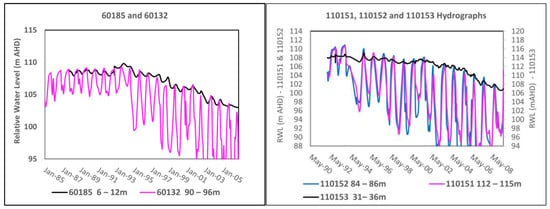
Figure 15.
Connection across the entire saturated aquifer system shown by the sympathetic fall in levels from the shallow aquifer and water table to the Calivil Formation in response to pumping. Left. Type 1 response in non-irrigated and Right. Type 2 response in irrigated regions of the Campaspe Fan with return flow recharge [40].
A similar more general pattern of connection to that in the 62601/02 piezometer nest between shallow groundwater (including the water table) and the deep Calivil Formation occurs on the highly permeable Campaspe Fan where there are two distinct responses for connected systems –Type 1 and Type 2 [40]. With Type 1 responses the shallow and deep aquifers have the same hydraulic head and fall in unison as the aquifer drains, but in Type 2 they also fall in unison, but the shallow bore has a higher head with a downwards hydraulic gradient between the pair. The Type 1 response is restricted to the western non-irrigated part of the Campaspe Fan, while Type 2 occurs on the eastern irrigated part of the Fan where there is significant recharge from irrigation return flow reflected in the downwards directed hydraulic gradient Bore 62602, on the Coonambidgal terrace is a Type 2 response, but with recharge coming from the Coonambidgal aquifer and hence the river.
4.4.2. Disconnected Campaspe River at Fergusons Bridge
At Fergusons Bridge on the Campaspe River (Locality Figure 9 and Figure 16) intense studies involving drilling and monitoring were specifically designed to determine the impact of nearby groundwater pumping on river leakage but reflecting earlier views and confusion over the nature of river disconnection, led to strongly opposing conclusions. A triple piezometer nest WRK953017, 19 and 18 established at Fergusons Bridge immediately alongside the river is screened in the Coonambidgal and the upper and lower Shepparton Formation aquifers at 5–8 m, 12–15 m and 26–29 m, respectively (Table 2). Two additional piezometer nests covering the Shepparton Formation and Calivil Formation are located beyond the terrace on the Shepparton Formation plain. The observation bores provide an 18 year record of groundwater movement. In April 2005, all the Shepparton Formation bores and the deeper Calivil Formation bore had virtually the same hydraulic head of ~124.1 m asl, indicating a flat regional water table and a single unconfined aquifer throughout. However, the water table in the Coonambidgal Formation bore WRK953017, reflecting river levels at an elevation of 127.6 m was perched 3.5 m above the surrounding regional water table. The line of bores showed no mounding below the river in the underlying Shepparton Formation aquifer. In April 2005, the Coonambidgal Formation was an unconnected aquifer separated from the water table by a 3.0 m thick aquitard and a 3.5 m thick vadose zone (Table 3) which under the present regime of falling groundwater levels has now expanded to 12 m (Figure 17).
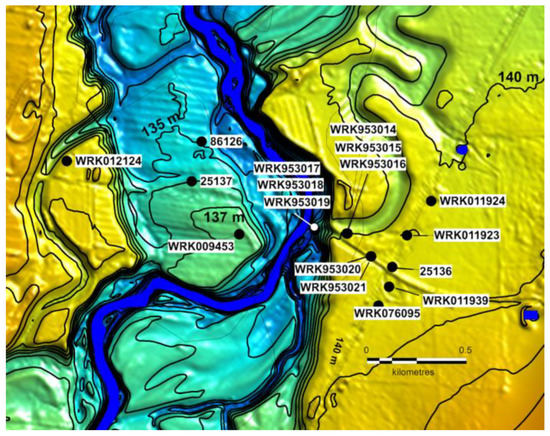
Figure 16.
Distribution of Coonambidgal Formation and the Shepparton Formation Plain at Fergusons Bridge. The WRK953017-19-18 piezometer nest is located alongside the river. Meanders of the earliest ancestral river phase occur lateral to the main AR2 terrace. 1 m contours (vicmap-elevation-dem-10 m–mod.).

Table 2.
Screened intervals and levels in observation bores.

Table 3.
Fergusons Bridge piezometer nest on Coonambidgal terrace, and nearby plain (853018).
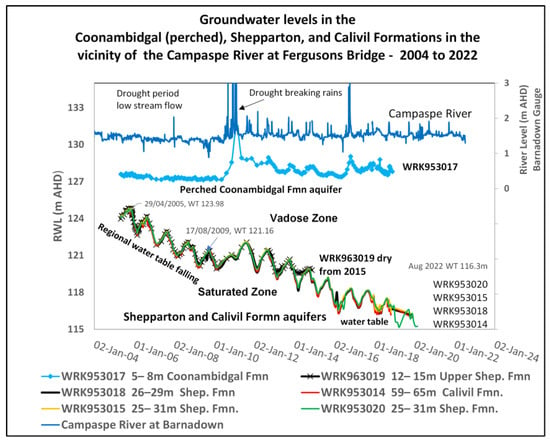
Figure 17.
Groundwater levels in piezometer nests in the vicinity of Fergusons Bridge. The WRK953017, 18 and 19 nest is located on the Coonambidgal terrace alongside the Campaspe River. Other bores are located on the Shepparton Formation nearby. The Coonambidgal bore WRK953017 does not respond to the falling levels in the Shepparton and Calivil aquifers but echoes the Campaspe River flow with spikes in 2011 and 2017. Bore WRK963019 went dry in 2015 as the water table fell and now lies within the expanding vadose zone.
Two additional piezometer nests covering the Shepparton Formation and Calivil Formation are located beyond the terrace on the Shepparton Formation plain (Figure 16). The observation bores provide an 18-year record of groundwater movement. In April 2005, all the Shepparton Formation bores and the deeper Calivil Formation bore had virtually the same hydraulic head of ~124.1 m asl, indicating a single unconfined aquifer throughout. However, the water table in the Coonambidgal Formation bore WRK953017, reflecting river levels, was perched 3.5 m above the surrounding regional water table at an elevation of 127.6 m Table 2). The line of bores showed a flat water table beneath the river with no mounding below the river in the underlying Shepparton Formation aquifer. In April 2005, the Coonambidgal Formation was an unconnected aquifer separated from the water table by a 3.5 m thick vadose zone which continued to thicken under the falling groundwater regime (Figure 17).
Groundwater monitoring at Fergusons Bridge has continued up to the present (2022), during which time levels in the Shepparton-Calivil aquifer have steadily fallen in response to nearby pumping. By contrast, the Coonambidgal aquifer is unaffected by pumping, and instead the water level fluctuates in a pattern which closely echoes that of the river level monitored upstream at the Barnadown gauge. Coonambidgal Formation levels show a strong connection with the river (Figure 17) as was the case at Avonmore Coonambidgal site 62599 (Figure 10). From the initial readings in 2004 regional water tables have fallen by 9 m, and by early 2022 the thickness of the vadose zone below the base of the Coonambidgal Formation had widened to 12 m, falling at a rate of about 0.5 m/y. as the aquifer drains in a reverse manner to that in which it filled last century. The present level is still about 6 m above that in 1926. The expanding vadose zone has seen the intermediate Shepparton Formation piezometer WRK853019 screened from 12 to 15 m go dry as the regional watertable fell below the screen. The river side and plains piezometers show that for any set time, the regional water table directly beneath the river remains flat, and at no stage is there mounding. The river and Coonambidgal aquifer are disconnected from the regional water table and may be described as a disconnected river with an associated aquifer. Neither nearby seasonal groundwater pumping nor the regionally falling water table impacts this reach of the Campaspe River.
An important aspect of disconnection is the aquitard at the top of the vadose zone developed within the uppermost Shepparton Formation. The aquitard at Fergusons Bridge is a 3 m thick grey and green clay. It is part of a widespread uppermost clay unit of the Shepparton Formation, a common feature observed by Neivandt [50] and Leonard [64]. Leonard and Macumber [66] also note that the upper Shepparton Formation beneath the Southern Campaspe Plain is predominantly clay with occasional disconnected sand lenses. With the overlying saturated river-fed Coonambidgal Fomation aquifer and an underlying vadose zone, both diffusion and dispersion under gravity flow over an extensive period of time would have chemically enhanced the aquitard, a process partly reflected by its colour. Blue and green clays indicate waterlogged anaerobic conditions with the reduction of ferric iron to ferrous. The thickness of the vadose zone below the base of the Coonambidgal aquifer in 2005 was 3.5 m, it is now 12 m, but was >20 m under the pre-settlement phase of steady-state hydrological equilibrium. The situation at Fergusons Bridge is similar to that downstream at Avonsmore. The aquitard and omnipresent vadose zone beneath the Campaspe River demonstrate that in the Southern Campaspe Plain it is a naturally unconnected stream contributing no significant recharge to the regional aquifer and unaffected by groundwater pumping from the regional Calivil Formation aquifer.
4.5. Ubiquitous Groundwater Trends and Their Implications for Previous River-Groundwater Disconnectivity
A similar pattern of groundwater level rises and falls to that at Fergusons Bridge and Avonmore occurs across the entire Southern Campaspe Plain between Barnadown (65875) and beyond Elmore. From the Campaspe Valley rates of water table rise averaging 0.25 m/year are documented for the past 100 years (Table 4; Figure 9); [6,7]). The end of the widespread century long rise in groundwater levels was brought about by the impact of 14 years of drought and the consequent intensification of groundwater extractions. The millennium drought began in 1997 and ended in 2010/2011, its end marked by the spike in river flow and groundwater levels in 2011 in the 62599 and 62602 terrace bores (Figure 18). The rising- falling trend occurs across the entire aquifer system whatever the depth, as shown by the conformity of levels in shallow, intermediate and deep bores. Exceptions are bores 54380 and 89888 which defy the trend and continue to rise at a similar rate to the Campaspe Valley long-term trend of 0.25 m/y. They are in alluvial and bedrock aquifers located high on the valley sides where they are not subject to groundwater extraction. Their continuing trend demonstrates that the rise in levels across the Campaspe Valley was not due to loss from a strongly connected regulated river as was commonly assumed but was instead a response of a fragile hydrological regime destabilized after European occupation [6,7,8]. The trend observed in bedrock bore 89888 is repeated in the Bullock Creek embayment in alluvial bore 108928 (below) (both bores rising at 0.26 m/y. (R2 = 0.99).

Table 4.
Rates of water table rise across the upper Campaspe Valley 1900 to 1976 [6,7].
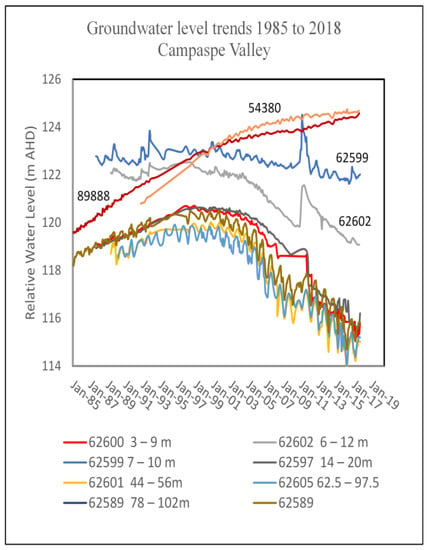
Figure 18.
Groundwater trends showing the rise and fall of regional groundwater levels across the Campaspe Valley between Barnadown and Elmore since 1985.
The Campaspe Valley trends reflect groundwater levels throughout the last century and the early 21st century which occurred in response to land-use changes, severe drought and groundwater extractions. The pattern was repeated across all areas of the southern Riverine Plains and highlands. The significantly deeper water tables that existed prior to 1900 have important ramifications for river-groundwater connectivity as disconnected streams and accompanying vadose zones were far more prevalent in the past Simultaneously, the process of chemical aquitard enhancement through river loss was an ongoing legacy from that era. Using groundwater data sets going back to the gold mining era of the 18th and early 19th century, the extent of the long term rise in groundwater levels may also be obtained for other regions where perched streams exist but with no groundwater extractions to dampen the trends. One such area is the embayment of the Bullock Creek at Marong where there is no fresh groundwater and hence no groundwater exploitation to mask earlier rises.
4.6. Bullock Creek Embayment at Marong–Rising Water Levels and Perching in a Dryland Setting
Bullock Creek rises in the highlands and passes northwards through Marong to join the Pyramid Creek to the west of Kow Swamp. Like the Campaspe River it occupies an embayment in the highland front (Figure 19). A feature of the embayment first identified during the mining era is the presence of a shallow water table perched above a thick vadose zone with a water table at ca 50 m.
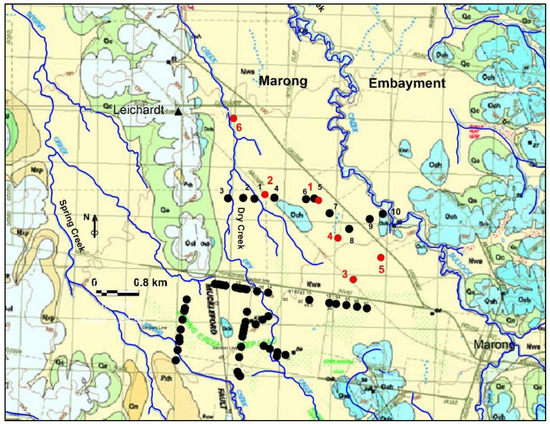
Figure 19.
Bullock Creek flows across a small embayment in the highland front formed by outcropping Ordovician sediments. The section lines shown are of boreholes drilled between 1904 and 1907 which provide lithology, groundwater levels and salinity data at the time. The northern line is numbered 1 to 10. Red dots are bores from recent drilling in 2011, numbered 1 to 6.
Flow in Bullock Creek is seasonal, but under high flows the creek is subject to sheet flooding, a factor in the recharge of the adjoining shallow shoe-string sand based groundwater system. Unlike the other areas considered in this work, Bullock Creek lies in a dryland province where the groundwater is too brackish for irrigation. The Marong embayment was intensively drilled from 1904–1907, during the gold mining era [72,73,74,75]. The drilling provided detailed information on the lithology together with groundwater levels and salinity at the time. The depth to bedrock varied markedly reaching 50 to 60 m over the deeper parts of the embayment. The regional water table in 1907 was brackish and met at about 49–50 m traversing both alluvial and bedrock aquifers (Table 5, [76,77]. Ferruginized layers occurring as cemented quartz grit occur throughout the sequence attesting to past chemical clogging and indicate the significance of iron as an agent in this process. Iron is a ubiquitous part of the Australian landscape and a significant component in groundwater (Figure 20). In a number of bores perched water was struck at shallow depths (Table 6), but the sequence thereafter remained dry until again met at ca. 50 m in the bedrock aquifer. Six additional bores (in red) were drilled in 2011 to examine the hydrology of the shallow aquifer (Figure 19).

Table 5.
Comparison of depth to water in bores in the Marong Deep Lead (1904 to 1907) with that measured in new Bore 3 in 2018. The rate of water table rise is 0.23 m/y.
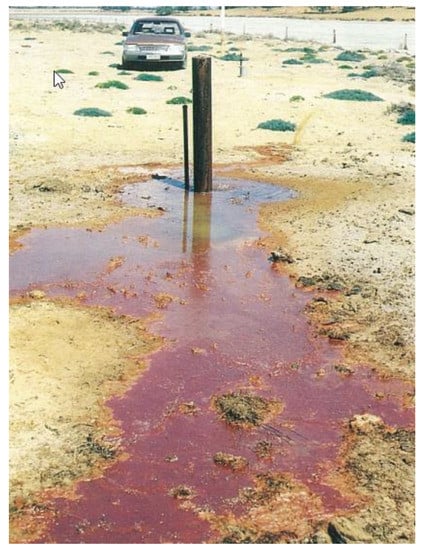
Figure 20.
Iron-trich groundwater flowing from an artesian bore in NW Victoria. The previously white plastic standpipe is iron encrusted, attesting to the rapidity of iron clogging [8].

Table 6.
Bores showing shallow perched groundwater (1907)—locality below.
In June 2011, the water table was at a depth of 26 m compared with ca 50 m in 1907, providing an approximate rate of rise of ca. 0.23 m/y. over 104 years. Bores 107928 and 107929 form a piezometer nest in the north of the Marong embayment where the water table is at 38 m in the basal alluvial sequence. A perched brackish water lens is contained within a 1 m thick coarse sand bed from 17–18 m which is essentially a clay enclosed collector for gravity drainage within an otherwise dry vadose zone, and the water levels are static. In the deeper water table bore 107918, there was a continuing rise of 0.26 m/y. between 1990 and 2016, which is similar rate to that of the longer term measurement, and also that in the Campaspe Valley occurring over the last century (Figure 21). There is no groundwater extraction, and the rate of rise has continued up until recent times. In this respect, the pattern and rate of rise mirrors those of the valley side bores 54380 and 89888 m which like 107928 are unaffected by groundwater extraction (above).
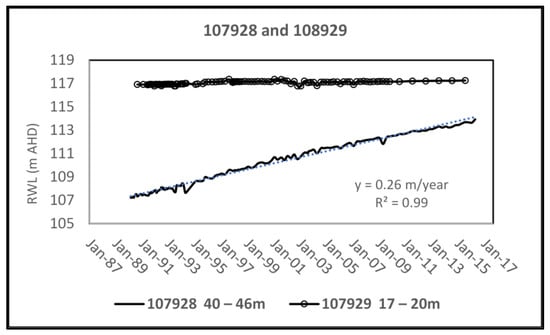
Figure 21.
Hydrograph of Bores in 107928 and 107929 piezometer nest, screened from 40–46 m at the base of the alluvial fill and from a 1 m sand bed continued to rise at 0.26 m/y. Bore 107929 is perched within a 1 m thick sand lens in the vadose zone.
In the Marong embayment traces of a perched shallow shoe-string aquifer network are present as linear depressions crossing the plain. As was the case in the earlier records, fresh groundwater was encountered in five of six sites targeting shoe-string sand aquifers, but it occurred only to a maximum depth of 7.1 m (Table 7). Below this depth all sites were dry and underlain by a variously thick vadose zone with the regional water table only being encountered in the deepest bore Site 3 at 26 m. In two instances small samples of brackish in-seepage from gravity drainage were obtained from the base of screens within the vadose zone, with salinities of 1260 mg/L (Bore 3) and 1900 mg/L (Bore 5).

Table 7.
Hydrochemistry of shallow groundwater, groundwater outcrop and gravity seepage (mg/L).
Bullock Creek at Marong flows within a Coonambidgal terrace system and is perched 26 m above the regional water table. The Goldfields bore 10 located alongside the creek has a 1.5 m thick layer of cemented sand and grit representing a cemented channel sequence and is underlain by yellow sandy white clay to 14.3 m which together form the original aquitard, since enhanced by the iron clogging of the overlying channel sand (Table 8). Water loss from the creek and the shallow aquifers is as seepage via gravitational flow down preferential pathways with perhaps some perching on discontinuous ferruginous layers or collection in thin sandy lenses. Clay layers and ferruginized quartz grits are common and occur at various depths forming aquitards of varying thickness, with the grits indicative of chemical clogging of shoe-string sand aquifers similar to those forming the near surface freshwater aquifers (Table 9). Perched 20+ m above the water table, Bullock Creek is a disconnected system like the Campaspe River or the pre-modern Pyramid Creek. Water loss from the creek and shallow aquifers are as seepage via gravitational flow down preferential pathways with perhaps some perching on discontinuous ferruginous layers. It is encountered as brackish water collected in the bottom of screens constructed in the vadose zone. The chemistry shows evolution from a carbonate facies of the recharging water to a chloride facies indicating some considerable period of residence time in the vadose zone.

Table 8.
Lithology of Bore 10 (1904-7) alongside Bullock Creek with cemented channel sand and underlying pre-existing aquitard.

Table 9.
Lithology of Bore 19 Section Line 2 shows distribution of ferruginous sand and pebble layers.
4.7. Loddon River–Baringhup
At Baringhup, the Loddon River is contained within a Coonambidgal Formation terrace composed of an argillaceous suite of clay and silt, characteristic of the low energy final AR3 phase. The terrace surface is undulating due to meander scroll, and earlier coarse grained AR1 and AR2 phases have been largely destroyed as the river meanders across a narrow bedrock-confined flood plain (Figure 22).
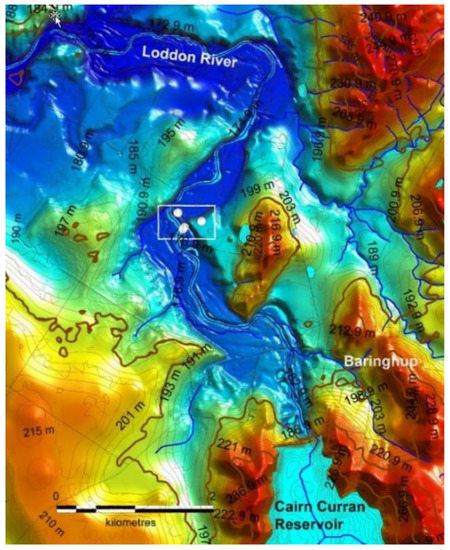
Figure 22.
The Loddon River at Baringhup forms part of the final stage low energy Coonambidgal terrace (AR3) composed of humic clay and silt. The position of three observation bores and a stratigraphic bore on the river terrace and a pumping bore on the Shepparton Formation are shown (vicmap-elevation-dem-10 m modified.).
Remnants of channel deposits occur as a quartz pebble lag on the edge and bed of the river, and as quartz pebbles enclosed in black clays forming the Coonambidgal Formation riverbed aquifer. Eucalyptus trees on the terrace tap the aquifer and are categorized by the Bureau of Meteorology in their Atlas of GDEs as a ‘high potential’ Groundwater Dependent Ecosystem. The Loddon River and the Coonambidgal Formation aquifer have much the same salinity (ca 400 mg/L) and the aquifer responds to river fluctuations indicative of the close relationship between river and aquifer seen elsewhere (Figure 23).
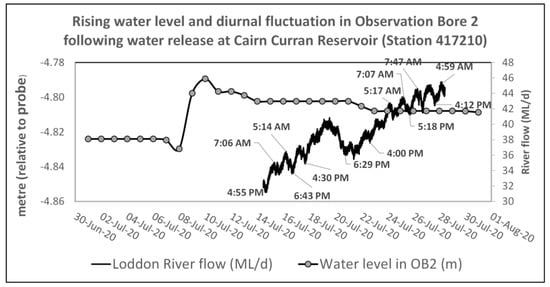
Figure 23.
Rise in water levels in Coonambidgal Formation OB2 bore in response to water release from Cairn Curran Reservoir on 9 July. The commencement of the groundwater rise was not recorded. The rising water table has superimposed diurnal fluctuations due to transpiration by eucalypts on the terrace, with levels being lowest in late afternoon but rising overnight to peak in the early morning.
As was the case in the Campaspe Valley, the regional Calivil Formation aquifer consists of coarse sand and wash (gravel and pebbles), and the overlying Shepparton Formation contains alternating coarse sand and clay bands, with a thicker uppermost clay (Table 10). Similarly, within the Loddon Valley highland tract the Shepparton and Calivil Formations behave as a single dual component aquifer having an equivalence of levels in the deep and shallow piezometer nests [40]. Long term groundwater levels follow the trends observed more generally across the State whereby groundwater levels rose last century before reversing following the impact of the millennium drought. At Baringhup, as elsewhere, on the basis of projection, the regional water table was previously lower than that at present (Figure 24).

Table 10.
Lithology and stratigraphy of the Calivil Formation irrigation bore.
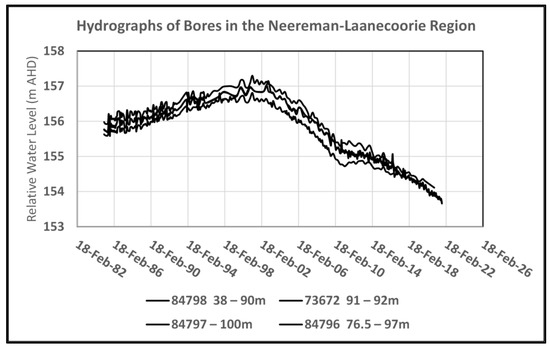
Figure 24.
Rising then falling groundwater levels in the Calivil Formation to the north of Baringhup.
At Baringhup potential river impacts were investigated by pumping from a Calivil Formation bore 320 m distant and observing in three observation bores established on the Coonambidgal terrace. Two observation bores (OB 2 and OB 3) were screened from 5 to 6 m in a clayey pebble channel deposit in the Coonambidgal Formation aquifer and a further bore OB 1 (screen 10–17 m) formed a piezometer nest alongside OB 2 developed in a shoestring sand lens in the upper Shepparton Formation (Figure 25). Both Coonambidgal bores OB 2 and OB 3 had the same low salinity water as the river (350–450 mg/L) showing a direct connection (Table 11). However, the deeper Shepparton Formation bore OB 1 was brackish (2800 mg/L). There is presently no vadose zone between the Coonambidgal and Shepparton Formation aquifers, however previously groundwater levels in the regional Calivil/Shepparton Formation were lower, as extrapolated at Neereman and Laanecoorie areas immediately to the north and exemplified by the trends elsewhere across the state. A fourth stratigraphic bore through the Coonambidgal sequence was drilled on the terrace between OB3 and the river.
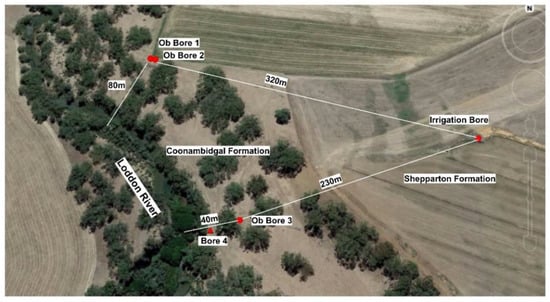
Figure 25.
Location of observation bores (OB1–screen 13–9 m; OB2 and OB3–screens 5–6 m); stratigraphic bore (Bore 4); and extraction bore (screen 45–70 m). The strip eucalypt forest is a Terrestrial GDE tapping groundwater in the 9 m thick Coonambidgal Formation.

Table 11.
Salinity, screened interval, and water levels of Loddon River, irrigation and observation bores (sampled on 10 June 2020).
The Coonambidgal Formation at Baringhup consists of a 9 m thick mostly fine-grained suite of an upper silt, humic clay with minor lignite, clayey pebbles with some sand, and a basal blue-black clay (Figure 26). The pebbles and humic black clay and lignite are from backfilling of the successive meander scrolls developed on the forested terrace, and the upper silt from overbank deposits during flooding. On lithology alone the 6 m clay terrace sequence might be considered as an aquitard but one which contains a 2 m thick partially clay clogged pebble layer as the nominal water-table aquifer, which has the same salinity as the river and responds to river level fluctuations.
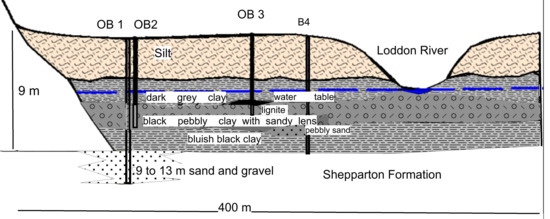
Figure 26.
Lithology of the Coonambidgal Formation at Baringhup with observation bores 1 to 3 and stratigraphic bore B4.
The river bed is incised through the silt. Pebbles similar to those in the aquifer outcrop along the banks of the river, where they are reworked into the present channel deposits (Figure 27). A basal black clay which predates the pebbly riverbed layer appears to be a relic of an earlier stage of river activity (Figure 28). The clay in the pebble matrix is from mechanical clogging of the riverbed aquifer which occurred after its abandonment when the channel filled with fine grained humic rich sediment in a cut-off billabong setting. A similar 4 m thick sand with black clay sequence was recorded from in the Coonambidgal Formation terrace downstream in bore 130559, where it overlies a coarse channel sand.
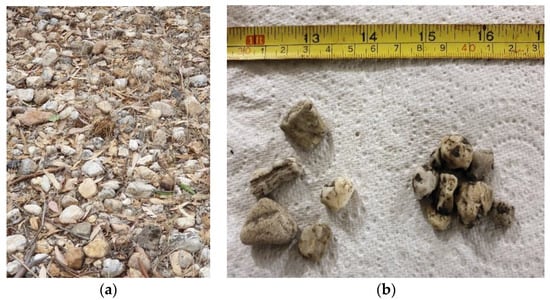
Figure 27.
(a) Quartz riverbed pebbles on a low terrace alongside the Loddon River; (b) quartz pebbles from the Coonambidgal channel deposit after washing.
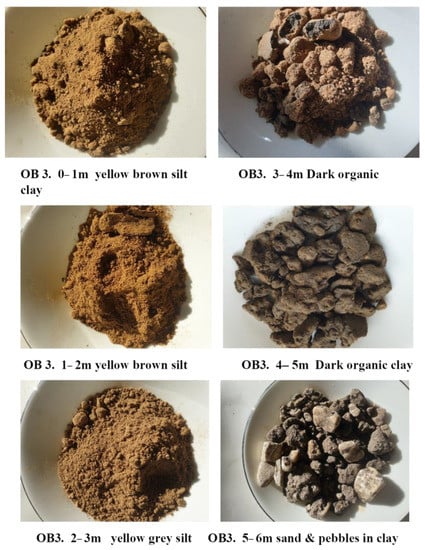
Figure 28.
Lithology at OB 3 bore with depths, showing overbank flow silts (1 to 3 m) overlying meander fill humic clay (black colour most visible on broken peds in 3–4 m sample) and <0.5 to 2 cm quartz pebbles (washed) which were coated in black clay. The clay surrounding the pebbles from 5 to 6 m is deemed to have been introduced during infilling after channel abandonment.
The partially clogged pebble bed is indicative of an aquitard, however groundwater with the same low salinity as the river (ca. 400 mg/L) occurs in the OB 2 and OB 3 observation bores located 80 and 40 m from the river, and they respond to river flow. From a range of approaches adopted, the 2 m of deeper blue-black clay was shown to be a tight aquitard separating the pebble aquifer from the Shepparton Formation sand aquifer in the OB 2 and OB 1 piezometer nest (Table 12). Light grey, blue, bluey-grey, green, dove-grey-red colours and mottling are a common feature of gleyed sediments from the reduction of ferric (Fe3+) to ferrous (Fe2+) iron. Gleys are sticky, compact and structureless with high water retention and low permeability [78]. They develop under conditions of intermittent or permanent waterlogging in an anaerobic environment [79,80,81,82]. They are commonly attributable to the influence of a shallow or fluctuating groundwater table, as might be the case with an unregulated Loddon River source. While commonly associated with soils, groundwater gleys occur in alluvial sequences, and sticky white, grey and blue clays are commonly referred to by miners and drillers as ‘pug’ or ‘pug clay’. A feature of the clay is its plasticity, and, where used in the pottery industry it is defined as a clay moistened and worked so as to be plastic. Black and blue clays pug clays occur to the south of Baringhup in the valley fill of Sandy Creek, a tributary of the Loddon River which flows into Cairn Curran reservoir. The alluvial sequence at Sandy Creek is 30 m thick with evidence for reducing conditions conducive to gleying associated with coarse gravels and pebbles. Blue and black clay and pug clay are recorded in bores 94114 (Table 13), 94116 and 94109. In bore 94115, located 800 m distant, blue and black pug is present between 9 and 15 m with ‘blue pug clay’ occurring with cobbles from 20 to 22 m at the base. In Bore 94109, blue pug clay occurs between 26 and 30 m. In colour, texture and fluvial setting, the black and blue pug clays from Sandy Creek are similar to those present in the terrace bores at Baringhup. As was the case with the iron clogging in the Bullock Creek sections, the clay pug clogging at Sandy Creek also demonstrates the permanency of clogged aquifer sequences.

Table 12.
Composite lithology and stratigraphy of Observation Bores 1 and 2 piezometer nest (see also Figure 28).

Table 13.
Lithology of Bore 94114, Sandy Creek Baringhup.
Phang et al. [48] examined gleys from a number of geological settings in Australia including those in Quaternary alluvium. They note that at Northparkes Cu-Au mines, located 300 km west of Sydney in NSW, gleying is common. They note that at the base of a palaeochannel there are gradational boundaries into the surrounding gleyed matrix due to very poor internal drainage within the clayey palaeochannel sediments. Gleyed sequences have low permeability, and at Northparkes it was suggested that gypsum formed as the result of ponding and evaporation above an impeded layer of gleyed clay. While the organic rich clayey pebbles of the Coonambidgal terrace of Baringhup are a partially clogged aquifer, the blue-black basal clay layer is a basal aquitard ensuring the hydraulic isolation of the Coonambidgal Formation from the underlying Shepparton Formation. The effectiveness of the 2 m thick aquitard is shown by:
- a lack of response from the OB 2 and OB 3 Coonambidgal Formation piezometers when pumping from the Calivil aquifer, despite the underlying Shepparton Formation bore OB 1 being strongly affected.
- the significant salinity differential either side of the aquitard (400 mg/L in the Coonambidgal Formation OB 2 and 2800 mg/L in the Shepparton Formation bore OB 1).
- Fine-scale fluctuation patterns are semi-diurnal in the Shepparton Formation, reflecting an earth tide influence, but diurnal in the Coonambidgal Formation due to evapotranspiration from the wooded terrace.
4.8. Transpirational Diurnal and Earth Tide Semi-Diurnal Groundwater Fluctuations as an Indicator of Aquifer Separation at Baringhup
Fine scale semi-diurnal fluctuations were observed in the data logger attached to the Shepparton Formation observation bore OB1 both prior to pumping from the Calivil Formation and during the later stages of recovery, becoming visible only as the curves flattened. The fluctuations had an amplitude of several cm and were superimposed on the 70 cm drawdown curve induced by pumping (Figure 29 and Figure 30). Semi-diurnal patterns are attributed to earth tides acting on a confined aquifer [83,84,85,86]. There was no drawdown in the Coonambidgal Formation OB 2 and OB 3 bores when pumping, only small scale diurnal fluctuations. The fluctuations observed in OB 2 and OB 3 conform to evapotranspirative (ET) patterns developed beneath forested areas (Figure 31 [87,88,89]. ET-induced fluctuations have a characteristic diurnal periodicity with the water table rising overnight before peaking in early morning, then falling during the day at the time of maximum transpiration to a low point in the afternoon [90]. The diurnal fluctuations occurring in the OB 2 and OB 3 bores are in response to evapotranspiration from the Eucalypt GDEs on the terrace. The different daily patterns of oscillation in the Coonambidgal aquifer and the Shepparton Formation are a reflection of their isolation, and hence isolation of the river from the Shepparton/Calivil Formations.
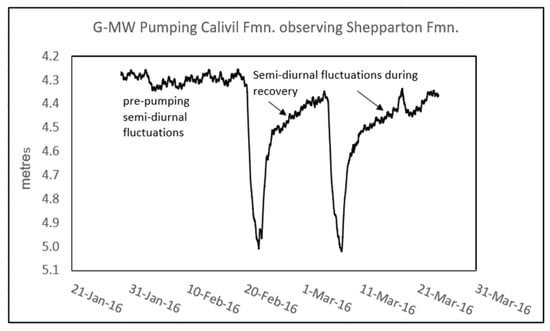
Figure 29.
Drawdown-recovery curves for Shepparton Formation—Observation Bore 1 (G-MW data) when pumping from the Calivil Formation bore, 320 m distant. During the pre-pumping phase prior to 19 February and the later recovery phases, fine scale low amplitude semi-diurnal fluctuations are present in response to earth tides (Figure 30).
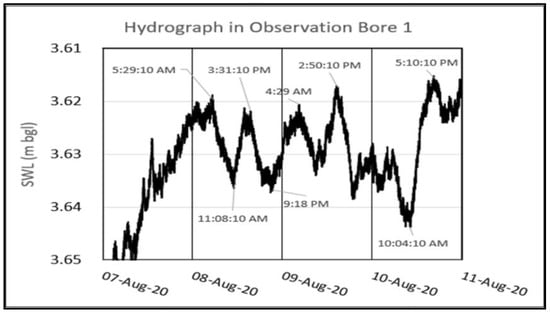
Figure 30.
Semi-diurnal fluctuations produced in OB1 in August 2020.
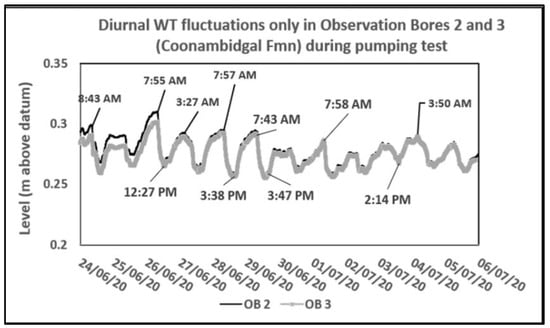
Figure 31.
Diurnal fluctuations from eucalypt evapotranspiration on the Coonambidgal terrace occur in the Coonambidgal Bores OB2 and OB3. When pumping from the Calivil Formation bore. here is no impact on the Coonambidgal bores as occurs in Figure 29.
At Baringhup, the Loddon River flows within an envelope formed by the Coonambidgal Formation with which there is a strong hydraulic connection. A humic blue-black clay aquitard at its base isolates the pebbly Coonambidgal Formation aquifer, and hence the river, from the underlying regional Shepparton/Calivil Formation aquifer. The effectiveness of the aquitard has been enhanced by physical and chemical processes occurring within the channel pebble layer and the basal clay which underwent gleying in a waterlogged humic rich anoxic zone developed above a previously unsaturated uppermost part of the Shepparton Formation. Pumping from the Calivil Formation does not impact the Coonambidgal Formation aquifer and hence it does not impact the Loddon River. While pump testing alone establishes the disconnection of the river and the Coonambidgal aquifer from the Calivil/Shepparton aquifer, strong and independent support for this view comes from the hydrochemistry and the daily fluctuation patterns.
5. Discussion
This work departs markedly from the traditional approaches in that for an understanding of disconnected rivers it moves away from riverbed flux and permeability, and areas ‘near or slightly below’ the riverbed. Instead, it places river connectivity into a temporal and spatial framework with consideration given to two issues–the physical characteristics of the Australian riverine landscape and an instability in the regional groundwater systems, which saw major rises in groundwater levels following European settlement and a decline in more recent years with widespread groundwater exploitation. The study considers the rivers as the surface expression of a fully integrated joint two-component river-strip aquifer system wherein water interchange is a reflection of river stage. With free lateral exchange between the terrace and the river via the channel bed aquifer, loss to the regional water table may be considered as loss between two aquifers. Riverbed permeability and flux is not a gauge of net river loss to the regional water table. Whatever vertical loss occurs is by either saturated or gravity flow through the floor of the strip aquifer whose width is 1 or 2 orders of magnitude larger than that of the river bed. In a disconnected stream aquitard development may occur within the aquifer by mechanical, biological, and chemical processes, or more commonly occurs from chemical processes active below the saturated aquifer, at the top of the vadose zone by diffusion and dispersion from above. Unlike riverbed clogging which is mostly mechanical and may be undone by high stream flow, aquifer clogging is largely chemical, and is both progressive and permanent. The marked rises in groundwater levels over the past century imply that disconnected rivers were more common in the past, and that the present aquitards are both a legacy and continuance of that regime. With disconnected aquifers groundwater pumping from the regional aquifer has no impact on the channel bed aquifer, and hence the river.
6. Conclusions
- The present-day major rivers flow within inset terraced meander belts, formed by successive phases of late Quaternary fluvial activity (Coonambidgal Formation), which form linear strip aquifers. The coarse bedload in successive meandering channels forms a basal aquifer of which the present riverbed is the most recent addition.
- The rivers are closely linked to the terrace aquifer through their common channel deposits, and together they form a single hydraulic entity with free water exchange, the direction depending on river stage. Given the ready lateral interchange, flux across the riverbed alone is not a measure of loss to the regional water table. This is instead determined by the flux through the base of the terrace aquifer, whose width is 1 or 2 orders of magnitude greater than that of the river bed. The loss may be seen as that occurring between two aquifers.
- Disconnected streams are buffered against drying by lateral inflow
- In disconnected rivers, the river and terrace aquifer are underlain by an aquitard and vadose zone. The aquitard is a lower permeability layer towards the top of vadose zone, or it may be within the terrace sequence. Clogging by mechanical, chemical, and biological processes occurs both in the riverbed and in the aquifer below the riverbed. Riverbed clogging is largely mechanical by siltation, but aquifer clogging is principally chemical and biological. Clogging in the sequence beneath the river/terrace may produce an aquitard if one does not previously exist as shown by the cemented ferruginous channel grit on Bullock Creek, or enhance the aquitard where one does exist, as along the Campaspe and Loddon Rivers.
- Physical clogging may occur during the formation of the heavily vegetated terraces by infilling of successive meander channels (billabongs) by organic rich clays. Clogging may also be post-depositional by physical and chemical processes including gleying under waterlogged anaerobic conditions. Clogging in the vadose zone has been demonstrated in laboratory experiments and under field conditions in artificial recharge projects and riverbank infiltration schemes. While riverbed clogging may be undone by high river flows, aquifer clogging is progressive and permanent
- The enhancement of an aquitard over time has implications for modern day river isolation. Instability in the groundwater systems which have seen regional water tables rise at rates of up to 0.25 m/y. or 25 m over the last century means that the vadose zone and present distribution of perched rivers is significantly less than what was previously the case. This has seen the disappearance of the vadose zone on the Pyramid Creek, but without removing its disconnection until mechanical removal of the aquitard. Whatever their distribution, the chemical enhancement of aquitards by clogging has been ongoing, and those at present are a legacy and continuation of processes active over time.
- While derived from northern Victoria, the work has implications to any area where there are river terraces, which is the case wherever larger rivers occur.
- The implications of this work are for groundwater and river managers. Individual rivers or streams cannot be deemed to have a uniform relationship to the water table along their course, as is commonly assumed. Furthermore, groundwater pumping near rivers, whatever the distance, may not be deleterious to the river. Conversely, pumping from the Coonambidgal terrace aquifers impacts the river, whatever its distance.
Funding
This research received no external funding.
Institutional Review Board Statement
Not applicable.
Informed Consent Statement
Not applicable.
Data Availability Statement
Not applicable.
Conflicts of Interest
The author declares that there is no conflict of interest.
References
- Brunner, P.; Cook, P.G.; Simmons, C.T. Hydrogeologic controls on disconnection between surface water and groundwater. Water Resour. Res. 2009, 45, 1422. [Google Scholar] [CrossRef]
- Brunner, P.; Simmons, C.T.; Cook, P.G. Spatial and temporal aspects of the transition from connection to disconnection between rivers, lakes and groundwater. J. Hydrol. 2009, 376, 159–169. [Google Scholar] [CrossRef]
- Brunner, P.; Therrien, R.; Renard, P.; Simmons, C.T.; Hendricks Franssen, H.J. Advances in understanding river-groundwater interactions. Geophysics 2017, 55, 818–854. [Google Scholar] [CrossRef]
- Przybyłek, J.; Dragon, K.; Michał, P.; Kaczmarek, J. Hydrogeological investigations of river bed clogging at a river bank filtration site along the River Warta, Poland. Geologos 2017, 23, 201–214. [Google Scholar] [CrossRef]
- Macumber, P.G. The Salinity Problem. In The Murray; Mackay, N., Eastburn, D., Eds.; Murray-Darling Basin Commission: Canberra, Australia, 1990. [Google Scholar]
- Macumber, P.G. Hydrological Equilibrium in the Southern Murray Basin. In The Hydrogeology of the Riverine Plain of South-Eastern Australia; Storrier, R.R., Kelly, I.D., Eds.; Australian Society of Soil Science Riverine Branch: Griffith, Australia, 1978; pp. 67–88. [Google Scholar]
- Macumber, P.G. Hydrologic change in the Loddon Basin: The influence of groundwater dynamics on surface processes. Proc. R. Soc. Vic. 1978, 90, 125–138. [Google Scholar]
- Macumber, P.G. Interaction between Groundwater and Surface Systems in Northern Victoria; Dept. Conservation and Environment: Melbourne, VIC, Australia, 1991; 345p. [Google Scholar]
- Rassam, D.; Walker, G.; Barnett, B. Recommendations for Modelling Surface-Groundwater Interactions Based on Lessons Learnt from the Murray–Darling Basin Sustainable Yields Project; A Report to the Australian Government from the CSIRO Murray-Darling Basin Sustainable Yields project; CSIRO: Canberra, Australia, 2008; 33p. [Google Scholar]
- Rosenberry, D.O.; Engesgaard, P.; Hatch, C. Hydraulic conductivity can no longer be considered a fixed property when quantifying flow between groundwater and surface water. Hydrol. Process. 2021, 35, e14226. [Google Scholar] [CrossRef]
- Rassam, D.; Werner, A.D. Review of groundwater–surfacewater interaction modelling approaches and their suitability for Australian conditions. J. Hydrol. 2012, 424–425, 16–23. [Google Scholar]
- Kelly, B.J.F.; Timms, W.A.; Andersen, M.S.; McCallum, A.M. Aquifer heterogeneity and response time: The challenge for groundwater management. Crop Pasture Sci. 2013, 64, 1141–1154. [Google Scholar] [CrossRef]
- Cook, P.G.; Brunner, P.; Simmons, C.T.; Lamontagne, S. Groundwater 2010. What is a disconnected stream? In Proceedings of the Challenge of Sustainable Management, Groundwater 2010, Canberra, Australia, 31 October–4 November 2010. [Google Scholar]
- Brownbill, R.J.; Lamontagne, S.; Williams, R.M.; Cook, P.G.; Simmons, C.T.; Merrick, N. Interconnection of Surface and Groundwater Systems—River Losses from Losing-Disconnected Streams; Technical Final Report; NSW Office of Water: Dubbo, Australia, 2011. [Google Scholar]
- Riesen, S.V. Decreasing Bank Filtrate Portion Due to Clogging of Riverbeds (Uferfiltratverminderung durch Selbstdichtung an Gewiissersohlen). Ph.D. Thesis, Faculty for Civil Engineering and Surveyllance, University Karlsruhe, Karlsruhe, Germany, 1975. (In German). [Google Scholar]
- Schalchli, U. The clogging of coarse gravel river beds by fine sediments. Hydrobiologia 1992, 235, 189–197. [Google Scholar] [CrossRef]
- Hiscock, K.M.; Grischek, T. Attenuation of groundwater pollution by bank filtration. J. Hydrol. 2002, 266, 139–144. [Google Scholar] [CrossRef]
- Grischeck, T.; Bartak, R. Riverbed Clogging and Sustainability of Riverbank Filtration. Water 2016, 8, 604. [Google Scholar] [CrossRef]
- Pholkern, K.; Srisuk, K.; Grischek, T.; Soares, M.; Schafer, S.; Archwichai, L.; Saraphirom, P.; Pavelic; Wirojanagud, W. Riverbed clogging experiments at potential river bank filtration sites along the Ping River, Chiang Mai, Thailand. Environ. Earth Sci. 2015, 73, 7699–7709. [Google Scholar] [CrossRef]
- Martin, R. Clogging Issues Associated with Managed Aquifer Recharge Methods; IAH Commission on Managing Aquifer Recharge: Mount Gambier, Australia, 2013. [Google Scholar]
- Skolasińska, K. Clogging microstructures in the vadose zone—Laboratory and field studies. J. Hydrogeol. 2006, 14, 1005–1017. [Google Scholar] [CrossRef]
- Zhang, Y.; Hubbard, S.; Finsterle, S. Factors Governing Sustainable Groundwater Pumping near a River. Groundwater 2011, 49, 432–444. [Google Scholar] [CrossRef] [PubMed]
- Lamontagne, S.; Taylor, A.R.; Cook, P.G. Interconnection of Surface and Groundwater Systems—River Losses from Losing/Disconnected Streams; Billabong Creek Site Report; CSIRO: Canberra, Australia, 2011. [Google Scholar]
- Lamontagne, S.; Taylor, A.R.; Cook, P.G.; Hamilton, S. Interconnection of Surface and Groundwater Systems—River Losses from Losing/Disconnected Streams; Macquarie River Site Report; Water for a Healthy Country Flagship: Adelaide, Australia; CSIRO: Canberra, Australia, 2011; p. 32. [Google Scholar]
- Lamontagne, S.; Taylor, A.R.; Cook, P.G.; Smithson, A. Interconnection of Surface and Groundwater Systems—River Losses from Losing/Disconnected Streams; Namoi River Site Report; Water for a Healthy Country Flagship: Adelaide, Australia; CSIRO: Canberra, Australia, 2011. [Google Scholar]
- Lamontagne, S.; Taylor, A.R.; Cook, P.G.; Barrett, C. Interconnection of Surface and Groundwater Systems—River Losses from Losing/Disconnected Streams; Gwydir River Site Report; Water for a Healthy Country Flagship: Adelaide, Australia; CSIRO: Canberra, Australia, 2011. [Google Scholar]
- Lamontagne, S.; Taylor, A.R.; Cook, P.G.; Gardner, W.P.; O’Rourke, M. Interconnection of Surface and Groundwater Systems—River Losses from Losing/Disconnected Streams; Border Rivers site report; Water for a Healthy Country Flagship: Adelaide, Australia; CSIRO: Canberra, Australia, 2011. [Google Scholar]
- Baevye, P.; Vandevivere, P.; Hoyle, B.L.; DeLeo, P.C.; Sanchez de Lozada, D. Environmental Impact and Mechanisms of the Biological Clogging of Saturated Soils and Aquifer Materials. Crit. Rev. Environ. Sci. Technol. 1998, 28, 123–191. [Google Scholar] [CrossRef]
- Characklis, W.G.; Cunningham, A.B.; Escher, A.; Crawford, D. Biofilms in Porous Media. In Proceedings of the International Symposium on Biofouled Aquifers, Prevention and Restoration; Technical Publication Series; Cullimore, D.R., Ed.; American Water Resources Association: Bethesda, MD, USA, 1987; pp. 57–78. [Google Scholar]
- Rinck-Pfeiffer, S.; Ragusa, S.; Sztajnbok, P.; Vandevelde, T. Interrelationships between biological, chemical, and physical processes as an analog to clogging in aquifer storage and recovery (asr) wells. Water Res. 2008, 34, 2110–2118. [Google Scholar] [CrossRef]
- Jeong, H.Y.; Jun, S.C.; Cheon, J.Y.; Park, M. A review of clogging mechanisms and managements in aquifer storage and recover (ASR) applications. Geosci. J. 2018, 22, 667–679. [Google Scholar] [CrossRef]
- Hu, B.; Liu, L.; Chen, R.; Li, Y.; Li, P.; Chen, H.; Liu, G.; Teng, Y. The Impact of Clogging Issues at a Riverbank Filtration Site in the Lalin River, NE, China: A Laboratory Column Study. Sustainability 2022, 14, 9330. [Google Scholar] [CrossRef]
- Dillon, P.J.; Hickinbotham, M.R.; Pavelic, P. Review of International Experience in Injecting Water into Aquifers for Storage and Reuse; National Conference Publication; Institution of Engineers: Newcastle West, Australia, 1994; pp. 13–19. [Google Scholar]
- Pels, S. The present and ancestral Murray River system. Aust. Geog. 1964, 2, 111–119. [Google Scholar] [CrossRef]
- Pels, S. Radiocarbon dating of ancestral river sediments on the Riverine Plain of southeastern Australia. J. Proc. Roy. Soc. NSW 1966, 102, 18–195. [Google Scholar]
- Bowler, J.M. Quaternary Climate and Tectonics in the Evolution of the Riverine Plain, Southeastern Australia. In Landform Evolution in Australasia; Davies, J.L., Williams, M.A.J., Eds.; Australian National University Press: Canberra, Australia, 1978. [Google Scholar]
- Lawrence, C.R. Geology, Hydrodynamics and Hydrochemistry of the Southern Murray Basin. In Memoir 30; Geological Survey of Victoria, Mines Department: Melbourne, VIC, Australia, 1975. [Google Scholar]
- Kemp, J. The Hydrology, Geomorphology and Quaternary Palaeochannels of the Lachlan Valley, New South Wales. Ph.D. Thesis, The Australian National University, Canberra, Australia, 2001. [Google Scholar]
- Macumber, P.G. Progress Report on the Groundwater Survey of the Avoca and Loddon Valleys; Groundwater Investigation Report; Department of Mines: Melbourne, VIC, Australia, 1973; p. 9. [Google Scholar]
- Macumber, P.G.; Macumber, J.J. Groundwater flow in the Campaspe and Lod don Valleys of northern Victoria: An enhanced role for the Shepparton Formation. Proc. R. Soc. Vic. 2010, 122, 43–69. [Google Scholar] [CrossRef]
- Mueller, D. Rivers of the Last Glacial Maximum: A Southeast Australian Perspective. Ph.D. Thesis, School of Earth and Environmental Sciences, University of Wollongong, Wollongong, Australia, 2017. [Google Scholar]
- Page, K.; Nanson, G.; Price, D. Chronology of Murrumbidgee River palaeochannels on the Riverine Plain, southeastern Australia. J. Quat. Sci. 1996, 11, 311–326. [Google Scholar] [CrossRef]
- Stone, T. The late-Holocene origin of the modern Murray River course, southeastern Australia. Holocene 2006, 16, 771–778. [Google Scholar] [CrossRef]
- Baldwin, J.G.; Burvill, G.H.; Freedman, J.R. A Soil Survey of Part of the Kerang Irrigation District, Victoria; Bulletin 25; Commonwealth Council for Scientific and Industrial Research: Melbourne, Australia, 1939. [Google Scholar]
- Girdwood, J.G. Performance of An On-Farm Evaporation Basin for Disposal of Saline Water. In The Hydrogeology of the Riverine Plain of South-Eastern Australia; Storrier, R.R., Kelly, I.D., Eds.; Australian Society of Soil Science: Riverine Branch, Australia, 1978. [Google Scholar]
- Shrivastava, S.; Stewardson, M.J.; Arora, M. Understanding streambeds as complex systems: Review of multiple interacting environmental processes influencing streambed permeability. Aquat Sci. 2020, 82, 67. [Google Scholar] [CrossRef]
- Zhang, H.; Ye, X.; Du, X. Laws and Mechanism of the Fe (III) Clogging of Porous Media in Managed Aquifer Recharge. Water 2021, 13, 284. [Google Scholar] [CrossRef]
- Phang, C.; Wildman, J.; Anand, R. Post depositional weathering features and processes in sediments—Based on selected sites in Australia. In Regolith; Roach, I.C., Ed.; CRC LEME: Bentley, Australia, 2004; pp. 273–275. [Google Scholar]
- Macumber, P.G. Groundwater in the Campaspe Valley, January 2008. Prepared for Goulburn-Murray Water. Available online: https://www.academia.edu/26202052/Groundwater_in_the_Campaspe_Valley_Victoria_Australia (accessed on 22 December 2022).
- Neivandt, R. The Geomorphology, Sediments and Soils of the Mid Campaspe Valley, Victoria and Relationships to Groundwater Recharge. Bachelor’s Thesis, Dept of Geology, University of Melbourne, Melbourne, Australia, 1990. [Google Scholar]
- Williamson, R.J. Campaspe irrigation district model. Unpubl. Rep. 1984153. Geol. Surv. Vic. 1984, 70, 53p. [Google Scholar]
- Tickell, S.J. The deep aquifer, northern Victoria, horizontal groundwater flow and recharge. Geol. Surv. Vic. 1983, 42, 9p. [Google Scholar]
- Bridley, S.F. Groundwater recharge in part of the Campaspe Irrigation District; Rural Water Commission of Victoria: Melbourne, VIC, Australia, 1985; 26p. [Google Scholar]
- Nolan, J.G.; Olshina, A.; Carney, P.; Bartley, J. Shepparton Regions Options. Recharge to the Deep Lead by Numerical Simulation; Department of Industry, Technology and Resources: Melbourne, VIC, Australia, 1988. [Google Scholar]
- Arad, A.; Evans, R. The Hydrogeological Hydrochemistry and Environmental Isotopes of the Campaspe River Aquifer System, North-Central Victoria, Australia. J. Hydrol. 1987, 95, 63–86. [Google Scholar] [CrossRef]
- Brinkley, A.; Reid, M.; Mavrakis, M. Campaspe Valley Conjunctive Use Study, Part 2: Aquifer Pumping Test Analysis Report; Investigations Branch Unpublished Report No. 1991/31; Rural Water Commission of Victoria: Melbourne, VIC, Australia, 1991. [Google Scholar]
- Chiew, F. Estimating Groundwater Recharge Using an Integrated Surface and Groundwater Model. Ph.D. Thesis, University of Melbourne Department of Civil and Agricultural Engineering, Melbourne, Australia, 1990. [Google Scholar]
- Chiew, F.; McMahon, T. Groundwater Recharge from Rainfall and Irrigation in the Campaspe River Basin. Aust. J. Soil Res. 1991, 29, 651–670. [Google Scholar] [CrossRef]
- Chiew, F.; McMahon, T.; Dudding, M.; Brinkley, A. Technical and Economic Evaluation of the Conjunctive Use of Surface and Groundwater in the Campaspe Valley, North-Central Victoria, Australia. Water Resour. Manag. 1995, 9, 251–275. [Google Scholar] [CrossRef]
- Dudding, M.; Chiew, F.; Brinkley, A. Campaspe Valley Conjunctive Use Study Part 3 Technical and Economic Evaluation Report; RWC Investigations Branch Unpublished Report No. 1991/33.
- Dyson, P.; Macumber, P.; Reid, M.; Perry, R. The Feasibility of Groundwater Pumping for Salinity Mitigation and Regional Development in the Dryland Riverine Plains of the Loddon and Campaspe Catchments; Technical Report No. 62; Centre for Land Protection Research: Bendigo, Australia, 1999. [Google Scholar]
- Nolan-ITU. Campaspe Deep Lead GSPA Groundwater Model; Draft Final Report; Victorian Department of Natural Resources and Environment: Melbourne, Australia, 2001. [Google Scholar]
- Evans, R. Statement of Evidence; Bickley vs. Goulburn-Murray Water; Sinclair Knight Marz: Armadale, Australia, 2005. [Google Scholar]
- Leonard, J.G. Bickley versus Goulburn Murray Water; John Leonard Consulting Services: Armadale, Australia, 2005. [Google Scholar]
- Trewhella, N.W. Assessment of Groundwater Licensing Issues in the Matter of Bickley Crests Goulburn-Murray Rural Water Authority; History Making Pty Ltd.: Maldon, Australia, 2005. [Google Scholar]
- Leonard, J.; Macumber, P.G. Southern Campaspe River—Groundwater Interaction, Murray Basin, Northern Victoria; Proc. MDBC Groundwater Workshop; Academia: Canberra, Australia, 2007. [Google Scholar]
- Macumber, P.G.; Leonard, J.G. Groundwater-Surface Water Interactions in the Campaspe Valley of Northern Victoria; Proc. MDBC Groundwater Workshop; Academia: Canberra, Australia, 2007. [Google Scholar]
- Wade, A.; Cossens, B. Stream-Aquifer Interaction in the Lower Campaspe Valley, Victoria, Australia—An example of “Fortuitous Aquifer Recharge”. Hydrol. Water Resour. Symp. 2014, 2014, 1010–1017. [Google Scholar]
- Leonard, J.G. Supplementary Statement of Evidence; Bickley versus Goulburn-Murray Water; John Leonard Consulting Services: Carnegie, Australia, 2006. [Google Scholar]
- Pratt, M.C. Report on Pump Test at Bore Elmore 31. Appendix E Part Two in Reid. 1988. [Google Scholar]
- Ife, D. Hydrogeological Mapping of the Upper Shepparton Formation, Shepparton Region; Investigations Branch Report; No. 1988/29; Rural Water Commission: Canaberra, Australia, 1988. [Google Scholar]
- Victorian Department of Mines. Drilling at Marong; Annual Report; Victorian Department of Mines: Melbourne, Australia, 1904. [Google Scholar]
- Victorian Department of Mines. Drilling at Marong; Annual Report; Victorian Department of Mines: Melbourne, Australia, 1905. [Google Scholar]
- Victorian Department of Mines. Drilling at Marong; Annual Report; Victorian Department of Mines: Melbourne, Australia, 1906. [Google Scholar]
- Victorian Department of Mines. Drilling at Marong; Annual Report; Victorian Department of Mines: Melbourne, Australia, 1907. [Google Scholar]
- Hunter, S.B. The Deep Leads of Victoria. Mem. Geol. Surv. Vict. 1909, 7, 145p. [Google Scholar]
- Chambers, F. Deep Lead Boring at Marong; Unpublished Report 1954/40A; Victorian Department of Mines: Melbourne, Australia, 1954. [Google Scholar]
- Albrecht, W.A. Calcium saturation and anaerobic bacteria as possible factors in gleization. Soil Sci. 1941, 51, 213–218. [Google Scholar] [CrossRef]
- Yamanaka, K.; Motomura, S. Studies on the gley formation of soils I. Soil Sci. Plant Nutr. 1959, 5, 134–140. [Google Scholar] [CrossRef][Green Version]
- PiPujol, M.D.; Buurman, P. The distinction between ground-water gley and surface-water gley phenomena in Tertiary Paleosols of the Ebro Basin, NE Spain. Palaeogeography 1994, 110, 103–113. [Google Scholar] [CrossRef]
- PiPujol, M.D.; Buurman, P. Analyzing ground-water gley and surface-water (pseudogley) effects in paleosols. Quat. Int. 1998, 51/52, 77–79. [Google Scholar] [CrossRef]
- Tabor, N.J.; Myers, T.S.; Michel, L.A. Sedimentologist’s Guide for Recognition, Description, and Classification of Paleosols; Kate, E.Z., William, G.P., Eds.; Terrestrial Depositional Systems; Elsevier: Amsterdam, The Netherlands, 2017; pp. 165–208. [Google Scholar]
- Melchior, P. Earth Tides. Surv. Geophys. 1974, 1, 275–303. [Google Scholar] [CrossRef]
- Van Der Kamp, G. Theory of earth tide and barometric effects in porous formations with compressible grains. Water Resour. Res. 1983, 19, 538–544. [Google Scholar] [CrossRef]
- Hsieh, P.A.; Bredehoeft, J.D.; Farr, J.M. Determination of aquifer transmissivity from earth tide analysis. Water Resour. Res. 1987, 23, 1824–1832. [Google Scholar] [CrossRef]
- McMillan, T.C.; Rau, G.C.; Timms, W.A.; Andersen, M.S. Utilizing the impact of earth and atmospheric tides on groundwater systems: A review reveals the future potential. Rev. Geophys. 2019, 57, 281–315. [Google Scholar] [CrossRef]
- Gribovszki, Z. Evapotranspiration impact on the diurnal fluctuation in a forested catchment. In Sopron; Mátyás, C., Vig, P., Eds.; NYME: Sopron, Hungary, 2004; Volume 4, pp. 171–183. [Google Scholar]
- Feikema, P.M.; Morris, J.; Connel, L. The water balance and water sources of a Eucalyptus plantation over shallow saline groundwater. Plant Soil 2010, 332, 429–449. [Google Scholar] [CrossRef]
- Loheide, S.P., II; Butler, J.J.; Gorelick, S.M. Estimation of groundwater consumption by phreatophytes using diurnal water table fluctuations: A saturated-unsaturated flow assessment. Water Resour. Res. 2005, 41, W07030. [Google Scholar] [CrossRef]
- Gribovszki, Z.; Szilagyi, J.; Kalicz, P. Diurnal fluctuations in shallow groundwater levels and streamflow rates and their interpretation—A review. J. Hydrol. 2010, 385, 371–383. [Google Scholar] [CrossRef]
Disclaimer/Publisher’s Note: The statements, opinions and data contained in all publications are solely those of the individual author(s) and contributor(s) and not of MDPI and/or the editor(s). MDPI and/or the editor(s) disclaim responsibility for any injury to people or property resulting from any ideas, methods, instructions or products referred to in the content. |
© 2023 by the author. Licensee MDPI, Basel, Switzerland. This article is an open access article distributed under the terms and conditions of the Creative Commons Attribution (CC BY) license (https://creativecommons.org/licenses/by/4.0/).